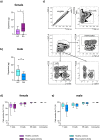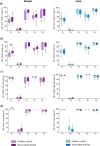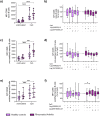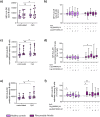Dopamine receptor 1 expressing B cells exert a proinflammatory role in female patients with rheumatoid arthritis
- PMID: 35396380
- PMCID: PMC8993840
- DOI: 10.1038/s41598-022-09891-6
Dopamine receptor 1 expressing B cells exert a proinflammatory role in female patients with rheumatoid arthritis
Abstract
Rheumatoid arthritis (RA) is a chronic rheumatic disease with a clear sex-bias. Recent data indicated a role for dopamine in RA pathogenesis, while dopaminergic pathways can be modulated by estrogens. As defined mechanism of action of dopamine on B cell function in RA are unclear, we aimed to elucidate this, with special focus on sex-differences. Healthy controls (HC, n = 64) and RA patients (n = 61) were recruited. Expression of D1-D5 dopamine receptors (DRs) was investigated by flow cytometry on peripheral blood mononuclear cells (PBMCs). D1-like DRs were stimulated in vitro to assess effects on B cell activation and proliferation. Secretion of cytokines and dopamine content were measured by ELISA. All DRs were expressed on PBMCs of HC and RA patients. Dopamine content in PBMCs, and frequency of D1DR expressing B cells were significantly higher in RA females (p < 0.001). Expression of D1DR on RA B cells correlated positively with disease duration and severity only in women. Combined B cell and D1-like DR stimulation induced higher IL-8 and CCL-3 secretion from PBMCs of female RA patients compared to HC. These results indicate sex-specific differences in dopaminergic pathway in RA, with a proinflammatory feature of the D1DR pathway in women.
© 2022. The Author(s).
Conflict of interest statement
The authors declare no competing interests.
Figures







Similar articles
-
Acute stimulation of PBMCs drives switch from dopamine-induced anti- to proinflammatory phenotype of monocytes only in women.Biol Sex Differ. 2025 Feb 3;16(1):8. doi: 10.1186/s13293-025-00689-5. Biol Sex Differ. 2025. PMID: 39901238 Free PMC article.
-
A regulatory effect of IL-21 on T follicular helper-like cell and B cell in rheumatoid arthritis.Arthritis Res Ther. 2012 Nov 23;14(6):R255. doi: 10.1186/ar4100. Arthritis Res Ther. 2012. PMID: 23176102 Free PMC article.
-
Dopamine receptor DR2 expression in B cells is negatively correlated with disease activity in rheumatoid arthritis patients.Immunobiology. 2015 Mar;220(3):323-30. doi: 10.1016/j.imbio.2014.10.016. Epub 2014 Nov 5. Immunobiology. 2015. PMID: 25468566
-
Activation of TGR5 alleviates inflammation in rheumatoid arthritis peripheral blood mononuclear cells and in mice with collagen II‑induced arthritis.Mol Med Rep. 2019 Nov;20(5):4540-4550. doi: 10.3892/mmr.2019.10711. Epub 2019 Sep 26. Mol Med Rep. 2019. PMID: 31702035 Free PMC article.
-
Dopamine, T cells and multiple sclerosis (MS).J Neural Transm (Vienna). 2017 May;124(5):525-542. doi: 10.1007/s00702-016-1640-4. Epub 2017 Mar 10. J Neural Transm (Vienna). 2017. PMID: 28283756 Review.
Cited by
-
Chlorpromazine directly inhibits Kv1.3 channels by facilitating the inactivation of channels.Mol Brain. 2025 May 8;18(1):41. doi: 10.1186/s13041-025-01211-z. Mol Brain. 2025. PMID: 40340862 Free PMC article.
-
Acute stimulation of PBMCs drives switch from dopamine-induced anti- to proinflammatory phenotype of monocytes only in women.Biol Sex Differ. 2025 Feb 3;16(1):8. doi: 10.1186/s13293-025-00689-5. Biol Sex Differ. 2025. PMID: 39901238 Free PMC article.
-
B cells and the stressed brain: emerging evidence of neuroimmune interactions in the context of psychosocial stress and major depression.Front Cell Neurosci. 2024 Apr 8;18:1360242. doi: 10.3389/fncel.2024.1360242. eCollection 2024. Front Cell Neurosci. 2024. PMID: 38650657 Free PMC article. Review.
-
Contemporary insights into neuroimmune interactions across development and aging.Front Neurol. 2025 Jul 25;16:1611124. doi: 10.3389/fneur.2025.1611124. eCollection 2025. Front Neurol. 2025. PMID: 40786636 Free PMC article. Review.
-
Dopamine D2 receptor on CD4+ T cells is protective against inflammatory responses and signs in a mouse model of rheumatoid arthritis.Arthritis Res Ther. 2023 May 26;25(1):87. doi: 10.1186/s13075-023-03071-1. Arthritis Res Ther. 2023. PMID: 37237413 Free PMC article.
References
MeSH terms
Substances
LinkOut - more resources
Full Text Sources
Medical
Research Materials

